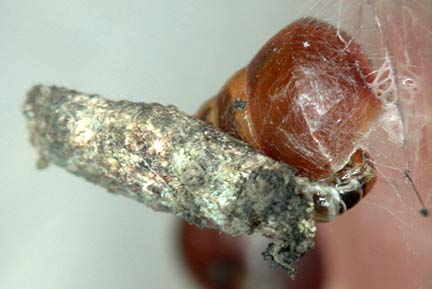
|
Unique isle caterpillar
feasts on unusual fare
A UH researcher says the species
is found only in Hawaii
The idea of a caterpillar that eats a snail seems impossible -- like finding a new species of wolf that dives for and dines on clams, says a University of Hawaii researcher.
But that is what Daniel Rubinoff of the College of Tropical Agriculture and Human Resources discovered and reported in yesterday's issue of the journal Science with his graduate student William Haines.
The unique behavior occurs in predatory caterpillars in the genus Hyposmocoma, found only in Hawaii, he said.
An assistant professor in the graduate program in entomology, Department of Plant and Environmental Sciences, Rubinoff said some folks on Maui knew he was working on the genus and found some caterpillars that seemed to be poking around in snail shells.
About 350 species have been described in the Hyposmocoma genus, and there are "more than twice that out there," he said. "A ton of them are unknown.
"It's a classic case of a scientist knowing too much," he said. "Initially, I just looked at global facts," he said, explaining there are 150,000 described species of Lepidoptera, immature caterpillars, butterflies and moths. Of those, he said, only 0.13 percent, or 200, are predators or parasites, "an incredibly small number, and all those that feed on other things feed on other insects or spiders.
"To find caterpillars feeding on snails was so unlikely."
Rubinoff and Haines went to Maui and collected some caterpillars. They tried to feed them carrot, lichen, algae and other things they are rearing 40 other species of Hyposmocoma on, Rubinoff said.
"They were starving, not eating anything. We put a snail in, and sure enough, they went after it. That was exciting ... one of those things: You see it but you can't believe it."
The caterpillars use a silk-spinning method to immobilize and capture their dinner, Rubinoff described. Binding the snail to the leaf where it was resting, the caterpillar wedges its cocoon next to or inside the snail shell. Then it stretches out to attack and consumes the snail, pursuing it to the end of its shell, he said.
All caterpillars are able to form cocoons of silk, but this is the first record of a predatory caterpillar using silk to catch live prey.
Rubinoff, an invasive-species biologist, said the snail-eating caterpillar was not reported in any other group of Lepidoptera, so he collected more caterpillars from the Makawao Forest on Maui and found some on Molokai.
"The freshest data," he said, "is we found new snail-eating species on Kauai and the Big Island, also. It really is exciting. Not only is this not a fluke, it occurs on Maui, Molokai and the other high islands."
Oahu is the only island where the unique caterpillars have not been found, at least yet, he said, speculating they might have been here historically and were the victims of environmental damage.
The caterpillars live mostly in native wet and rain forests and will not eat anything except native snails.
Rubinoff said the discovery is "tremendously exciting from an evolutionary and biological point of view. ... I hope it contributes to our understanding of what constraints or facilitates evolutionary change or novelty.
"It's sort of shocking that here we've got an exception. For some reason, in Hawaii we're getting something no one else has. People say, 'Why Hawaii?' I say, 'Why not elsewhere?'"
All mainland areas except Antarctica have snails and caterpillars, he said. "What is special about Hawaii?"
He suggests three possible reasons for Hawaii's snail-eating caterpillars to evolve: "What is absent and the right candidate lineage. Hyposmocoma was here to begin with, and they need land snails, a food source in abundance. Otherwise, caterpillars would never make the shift."
Predators or competitors for snails also were absent, he said, noting such things as ants and yellow jacket wasps, two huge predators in many mainland systems, are absent historically in Hawaii. "The absence of something like that left a space open for Hyposmocoma to make this unlikely switch."
Rubinoff said it is vital that remaining natural habitats be preserved to protect the caterpillars and yet-undiscovered evolutionary novelties unique to Hawaii.
www.ctahr.hawaii.edu/
Science Magazine
www.sciencemag.org
E-mail to City Desk
[News] [Business] [Features] [Sports] [Editorial] [Do It Electric!]
[Classified Ads] [Search] [Subscribe] [Info] [Letter to Editor]
[Feedback]
